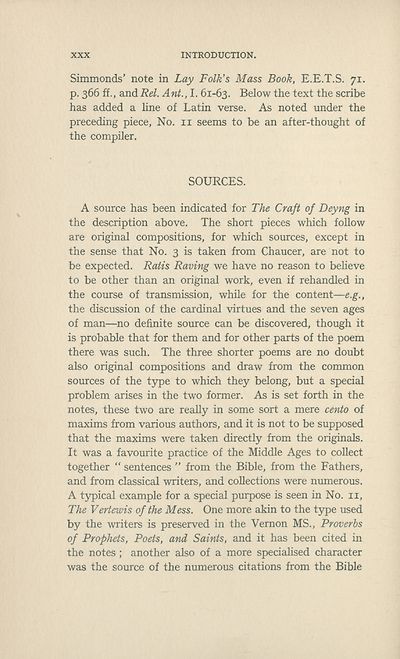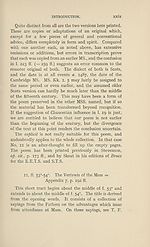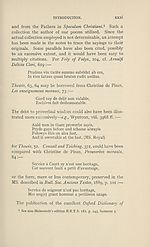Scottish Text Society publications > Third series > Ratis raving and other early Scots poems on morals
(40)
Download files
Complete book:
Individual page:
Thumbnail gallery: Grid view | List view

XXX
INTRODUCTION.
Simmonds’ note in Lay Folk’s Mass Book, E.E.T.S. 71.
p. 366 ff., andRel. Ant., I. 61-63. Below the text the scribe
has added a line of Latin verse. As noted under the
preceding piece, No. 11 seems to be an after-thought of
the compiler.
SOURCES.
A source has been indicated for The Craft of Deyng in
the description above. The short pieces which follow
are original compositions, for which sources, except in
the sense that No. 3 is taken from Chaucer, are not to
be expected. Ratis Raving we have no reason to believe
to be other than an original work, even if rehandled in
the course of transmission, while for the content—e.g.,
the discussion of the cardinal virtues and the seven ages
of man—no definite source can be discovered, though it
is probable that for them and for other parts of the poem
there was such. The three shorter poems are no doubt
also original compositions and draw from the common
sources of the type to which they belong, but a special
problem arises in the two former. As is set forth in the
notes, these two are really in some sort a mere cento of
maxims from various authors, and it is not to be supposed
that the maxims were taken directly from the originals.
It was a favourite practice of the Middle Ages to collect
together “ sentences ” from the Bible, from the Fathers,
and from classical writers, and collections were numerous.
A typical example for a special purpose is seen in No. 11,
The Vertewis of the Mess. One more akin to the type used
by the writers is preserved in the Vernon MS., Proverbs
of Prophets, Poets, and Saints, and it has been cited in
the notes ; another also of a more specialised character
was the source of the numerous citations from the Bible
INTRODUCTION.
Simmonds’ note in Lay Folk’s Mass Book, E.E.T.S. 71.
p. 366 ff., andRel. Ant., I. 61-63. Below the text the scribe
has added a line of Latin verse. As noted under the
preceding piece, No. 11 seems to be an after-thought of
the compiler.
SOURCES.
A source has been indicated for The Craft of Deyng in
the description above. The short pieces which follow
are original compositions, for which sources, except in
the sense that No. 3 is taken from Chaucer, are not to
be expected. Ratis Raving we have no reason to believe
to be other than an original work, even if rehandled in
the course of transmission, while for the content—e.g.,
the discussion of the cardinal virtues and the seven ages
of man—no definite source can be discovered, though it
is probable that for them and for other parts of the poem
there was such. The three shorter poems are no doubt
also original compositions and draw from the common
sources of the type to which they belong, but a special
problem arises in the two former. As is set forth in the
notes, these two are really in some sort a mere cento of
maxims from various authors, and it is not to be supposed
that the maxims were taken directly from the originals.
It was a favourite practice of the Middle Ages to collect
together “ sentences ” from the Bible, from the Fathers,
and from classical writers, and collections were numerous.
A typical example for a special purpose is seen in No. 11,
The Vertewis of the Mess. One more akin to the type used
by the writers is preserved in the Vernon MS., Proverbs
of Prophets, Poets, and Saints, and it has been cited in
the notes ; another also of a more specialised character
was the source of the numerous citations from the Bible
Set display mode to: Large image | Zoom image | Transcription
Images and transcriptions on this page, including medium image downloads, may be used under the Creative Commons Attribution 4.0 International Licence unless otherwise stated. ![]()
| Publications by Scottish clubs > Scottish Text Society publications > Third series > Ratis raving and other early Scots poems on morals > (40) |
|---|
| Permanent URL | https://digital.nls.uk/106919821 |
|---|
| Description | A collection of over 100 Scottish texts dating from around 1400 to 1700. Most titles are in Scots, and include editions of poetry, drama, and prose by major Scottish writers such as John Barbour, William Dunbar, Gavin Douglas, and George Buchanan. Edited by a key scholarly publisher of Scotland's literary history, and published from the late 19th century onwards by the Scottish Text Society. Available here are STS series 1-3. |
|---|

